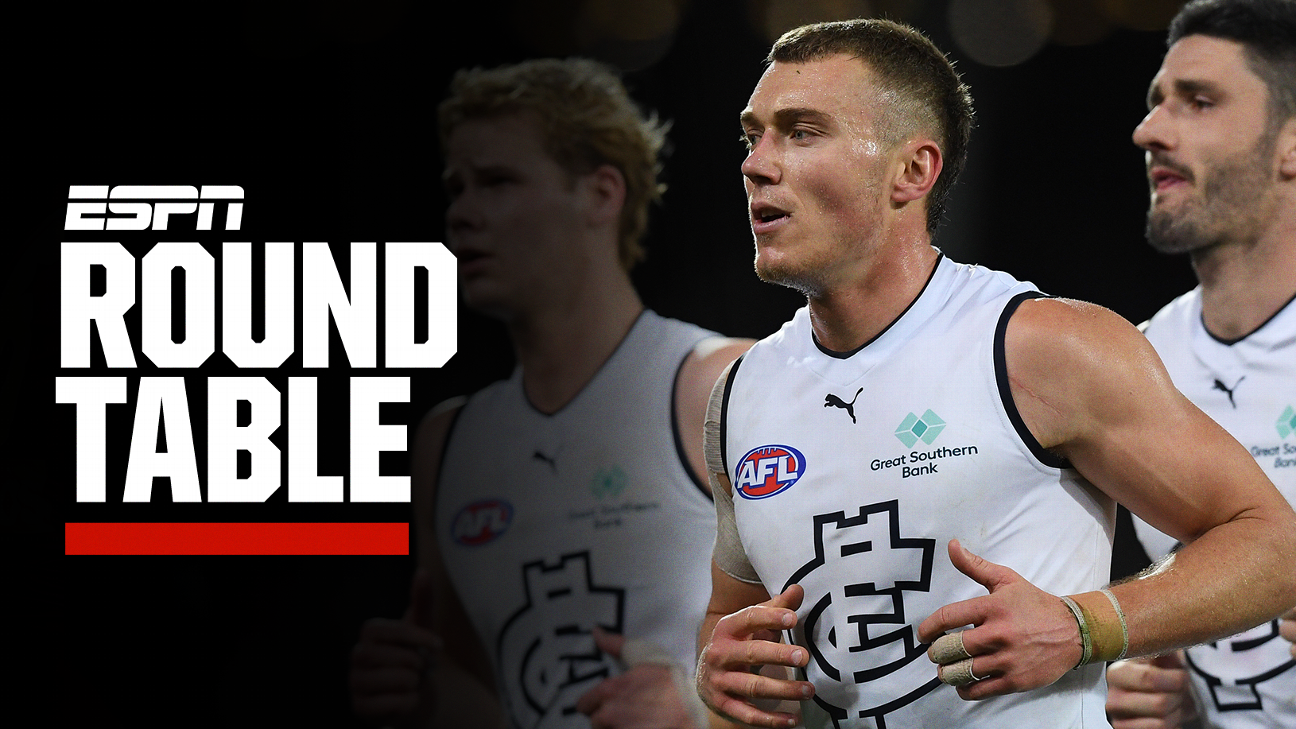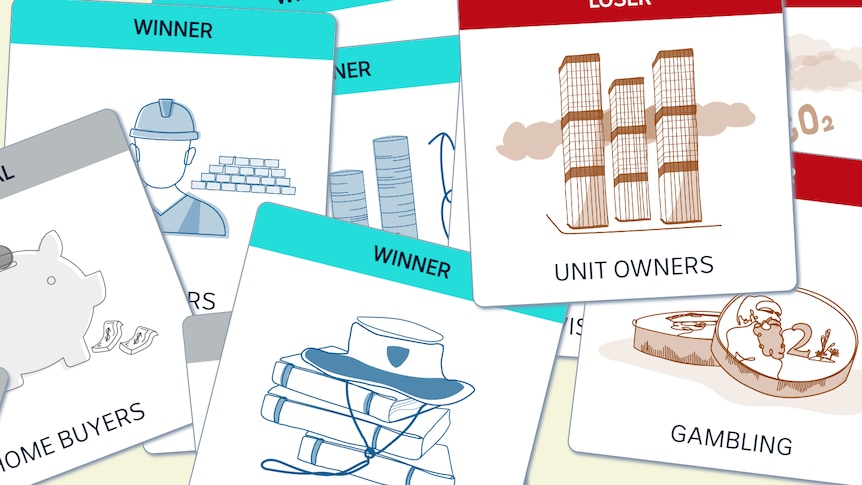Our AFL experts tackle some of the burning questions ahead of Round 21, including if Carlton loss to Adelaide will cost them a finals spot, the Round 21 game with the biggest stakes and what we really think about Collingwood.
Has Carlton blown their chance at September action?
Rohan Connolly: I suspect they might have. Have just done a ladder predictor, and I have the Blues missing out by a game to the Bulldogs, with Richmond in seventh spot. Brisbane (away), Melbourne and Collingwood is a bloody tough assignment. It’s a pity, really, because their emergence has been exciting, and they’ve done it against a continual backdrop of injury. But the bottom line is they’ve been too erratic over the second half of this season, 4-5 since being 8-2 after 10 rounds. And the loss to St Kilda when the Saints were in ordinary shape and last Saturday night’s disaster are probably the nails in the coffin.
Jake Michaels: Yes, the loss to the Crows was disappointing and inexcusable for a side which has been spoken about all year as a flag chance, but Michael Voss’ side still controls its destiny and remains a hot favorite to play in September. The Blues really only need to win one of their remaining three games, and while they are all tough, I can’t seem to them ending the season on a four-game losing streak. They make it in but I’m starting to reconsider just how much damage they can do…
Matt Walsh: Which Carlton will we see the rest of the year? Is it the one which went 8-2 and looked irresistible at times? Or the one which gives up games to St Kilda and Adelaide without showing so much as a whimper? That will determine where they finish on the ladder. They’re currently a game and a half inside the eight with somewhat healthy percentage; if they can snag a win over one of Brisbane (at the Gabba), or Melbourne and Collingwood (at the MCG) after that, they should make it, but lose all three and it’s a wasted season and, frankly, a failure on Michael Voss.
Jarryd Barca: They haven’t blown their chance completely, but they stumbled at a critical hurdle in that loss to Adelaide which only makes their path to September a little rockier. Their best is as good as — if not better than — anyone in the competition which is why I’ve been bullish about them all season, but the difference between their best and worst still seems too stark. Let’s not overreact here, though, they might not always reach the true heights of their ceiling, but I fully expect them to bounce back hard in the next three weeks as good teams do and at least snag one win – which should be enough.
Which game this week will have the biggest impact on finals?
RC: Wow, it’s a great round and there’s perhaps four games you could realistically argue are the most important in this sense. But I’m probably inclined to go with Geelong vs. St Kilda because it could affect both the battle for top and the battle for eighth, Melbourne in a position to re-take top spot if it wins by enough and the Cats stumble, and the Saints out of the eight if they lose and either Richmond or the Western Bulldogs win by any amount. That’s a wide range of ramifications.
JM: I’m looking at Friday night’s tasty clash between the Demons and Magpies. Melbourne’s looking more like the Melbourne we’ve become accustomed to but a top four berth is still far from secure, especially with games to come against the Magpies, Blues and Lions. If Collingwood gets up here and beats the Dees for the second time in 2022, they not only put a firm grasp on their own top four hopes but send significant concerns through the Demons camp. Can’t wait for it.
MW: The Western Bulldogs-Fremantle clash suddenly has my interest after Freo’s capitulation on Friday night against Melbourne. The Dockers are outside the top four now, and while they’re still a chance to climb back up to secure the double chance, equally, the Dogs will be rare to take down a contender to keep their slim, but not outrageous finals hopes alive . After the Dockers, the Bulldogs face GWS and Hawthorn, and with Carlton missing, there’s a real chance that a win this week could help to throw up some crazy first-week finals.
JB: Brisbane hosting Carlton at the Gabba with both teams coming off different kinds of brutal losses is as mouth-watering as it gets, with the Lions still fighting for a top four berth which we know is critical for interstate teams, and the Blues eager not to let their grip on the top eight loosen any more than it is. In terms of impacting finals, the top four isn’t out of the question for Michael Voss if his side can pull of an unlikely upset, and we can preempt the pressure that will ensue wth defeat, while facing Brisbane up north in an elimination final is a scary proposition for whoever may still scrape into the lower echelons of the eight.
What’s your strongest opinion about Collingwood right now?
RC: That they have had a sensational season whatever happens from here, with huge improvement considering they finished 17th in 2021. And I don’t buy the “lucky” argument or the inevitably of them being “found out” when it matters. Yes, you need an element of fortune to win close games, but nine wins from 10 games decided by 11 points or less is too big a sample to be purely lucky. Indeed, I think the fact last year they played in six games decided by 12 points or less and lost five is a good tangible indicator of their improvement.
JM: The Magpies are nowhere near as good as their record suggests. I’ll admit I was wildly wrong about the Pies at the start of the season (predicting them to finish bottom four) but are they a top four side? not chance. Percentage is a great indicator of how a side is traveling and there are currently EIGHT sides who have a better percentage than the Pies. Enough said.
MW: I’ve been saying for weeks to look at the percentage – it’s the best guide for where a team is ‘really at’. They’ve ground out some hard-fought wins, and have at times been fortunate (there’s nothing wrong with saying that!) but they’re not a power club that I can see winning at the end, let alone convincingly. Much like Sydney last year, I can see them finishing with a ‘home’ final in the first week but losing to a more experienced side. Plenty to look forward to, though.
JB: That while they’ve greatly exceeded expectations this season, we probably should have seen a rise coming after last year’s abysmal efforts, given the experience they still have. It’s easy to overreact in this game and that’s what most of us did, but actually having a good on-field year amongst the wild off-field distractions — a trade period ‘fire sale’, the fallout from the ‘Do Better’ report , Eddie McGuire stepping down and the ongoing board speculation and eventual upheaval, the removal of head coach Nathan Buckley mid-year and a range of injuries to key players which stipulated the blooding and exposure of the list’s youth — is virtually unimaginable. A far cry from this season’s fortunes, the Pies also lost five matches last season by under two goals (two by one point), so were more competitive than their 17th-placed finished suggested. Nah, they’re probably not a 14-5 team, but they were never going to be that bad.
Which bottom six side are you most optimistic about in 2023?
RC: Hawthorn. I was more bullish than most about the Hawks even before this season, and while a 7-12 record is hardly anything to write home about, I think they haven’t been far off the mark at all, seven of their losses by 27 points or less. I’m pretty upbeat about their young guys, too. It’s a pretty big group, and the likes of Newcombe, Jiath, Lewis, Koschitzke, Ward, Maginness are coming along quickly. I sense Sam Mitchell as coach is building a pretty solid brand of game, too, which will keep improving.
JM: Call me crazy but I’m still bullish on the Bombers. I picked them to make finals this year and am as surprised as anyone by their nosedive. With the likes of Zach Merrett, Darcy Parish, Dylan Shiel, Andy McGrath and Jye Caldwell, there’s a nice group of youthful midfielders. Players like Peter Wright, Sam Draper, Nic Martin and Mason Redman have had breakout years and should only improve, while the defense has the personnel to be far better than they have been this season. With an easier fixture (which they will get) I’m tipping them to bounce back next season.
MW: Hawthorn is not yet a year into its planned reset with Sam Mitchell at the helm, and, for the most part, they’ve exceeded my expectations. They’ve already matched their 2021 win tally of seven, and we’ve seen a different take from Mitchell and at the selection table. Strides have been taken by Mitch Lewis and Jai Newcombe. We’ve seen Changkuoth Jiath become an assured rebounder. Will Day is stringing together games, Josh Ward has impressed… there’s a heap to like about this list. If they can attract a big name in the next season or two, they could be playing finals sooner rather than later.
JB: I agree with Jake on this one, although I didn’t have them making it this season, I fully expect the Bombers to bounce back and play finals footy in 2023. Their defense is sound with Jordan Ridley, Jayden Laverde, Jake Kelly and Redman holding the fort while developing tall Zach Reid is waiting in the wings, they have a diverse midfield group with a range of strengths that can cause serious damage, and key forwards Peter Wright and the ever-improving Harrison Jones can form one of the most formidable forward 50 partnerships in the league. The puzzle pieces are there at The Hangar.
.

